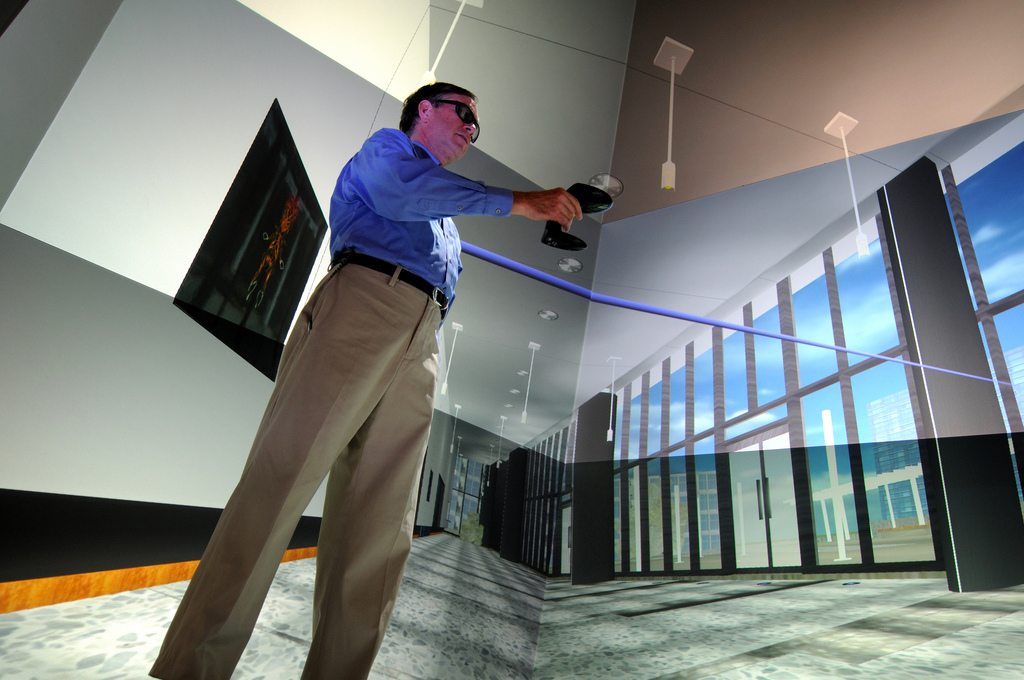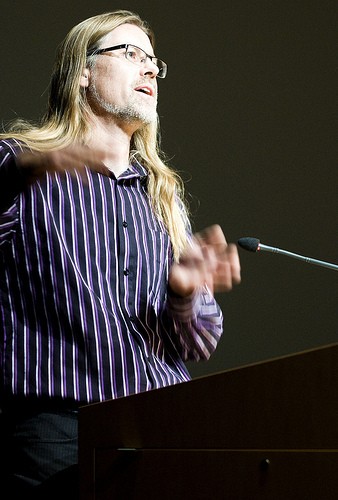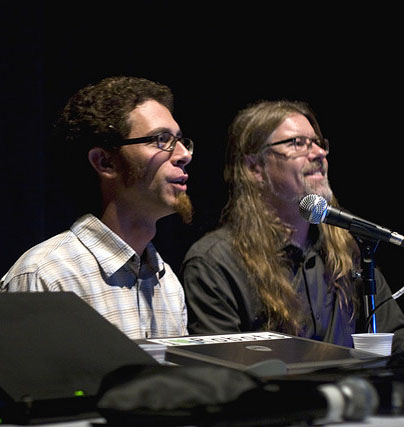CRCA, Calit2: Hotbeds of Activity in Visualization and Virtual Reality
San Diego, Oct. 19, 2010 -- The Center for Research in Computing and the Arts (CRCA) is gearing up to work on a number of projects that team CRCA researchers with counterparts from the UC San Diego division of the California Institute for Telecommunications and Information Technology (Calit2) and other campus units.
|
In addition, CRCA and Calit2 researchers have multiple papers accepted for the prestigious 2011 SPIE Electronic Imaging Conference taking place this January in San Francisco. The papers cover new technologies that range from an augmented reality system based on haptic feedback, to a novel means of acquiring stereo panoramic images for display in immersive virtual reality environments such as Calit2’s StarCAVE and NexCAVE systems. “The Engineering Reality of Virtual Reality” is the theme of SPIE 2011.
This Thursday, CRCA technical director Todd Margolis will also represent Calit2 at the world’s first Immersive Technology Summit, where he will talk about “Varieties of Virtual Experience”. [The summit will also showcase the inaugural Immersive Technology Awards, the ‘Immys’, for which public voting is still open; Calit2’s StarCAVE is currently in second place in the Research & Education category. To vote in the public poll, go to http://www.immersivetech.org/summit/immys/.]
CRCA is a UCSD organized research unit co-located with Calit2 on the La Jolla campus, where Brown has been Calit2 Artist in Residence and remains director of the university’s Experimental Game Lab.
NSF Grants
Together with Co-PI Lev Manovich (director of the Calit2-based Software Studies Initiative), principal investigator Brown recently received a two-year, $300,000 NSF CreativeIT grant for their project to develop “A Cultural Analytics Framework for Identifying and Integrating Creative Patterns of User Behavior and Experience in the Scalable City Multi-User Virtual World.” In this work, Brown and Manovich are creating more aesthetically sophisticated interactions in complex virtual worlds by working with assessments of visual experience.
[Editor’s note: Manovich is also the lead artist in a new exhibition in the gallery@calit2, located on the first floor of Atkinson Hall, which is home to both CRCA and Calit2. “Mapping Time: Visualizations of Temporal Patterns in Media and Art” will have its official opening on Friday, Oct. 22 with a panel discussion at 5pm and public reception from 6-8pm.]
|
This same group also received an instrumentation award of $136,060 under NSF’s Collaborative Research program. The project, “An Interactive ‘Human Sensor Situation Network’ for Improved Model Predictions,” seeks to develop software that will draw representations of an event of global or local significance from user generated content websites such as Flickr, YouTube, and Twitter and integrate these representations into a data cloud. Initially the project will apply its instrument to the recent Gulf Coast oil disaster and provide "instantaneous distributions and temporal frequencies of oil slicks, tar balls, and distressed and dead animals along the complete coastline of the Gulf Border States."
Another NSF grant to CRCA’s Brown will support undergraduate research in the CHMPR center. The grant supports students to assist in ongoing projects in which multicore computing techniques are devised to support next generation digital media projects.
SPIE 2011
The SPIE Electronic Imaging Conference next January will showcase a number of projects underway in CRCA and Calit2, pushing the envelope in the fields of virtual reality and immersive media. The SPIE conference is one of the premier conferences for the presentation of work related to all aspects of the field of electronic imaging. Papers and presentations are given on cutting edge imaging systems, image processing techniques, image quality, image processing and compression algorithms, sensor technology, and display technology.
|
CRCA researcher Micha Cárdenas with collaborators Laura S. Greci, Zia Agha M.D., Samantha Hurst, Karen Garman, Helene Hoffman, Ricky Huang, Michael Gates, Kristen Kho, Elle Mehrmand, Todd Porteous, A lan Calvitti and Erin Higginbotha will present a paper on "Productive Confusions: Learning From Simulations of Pandemic Virus Outbreaks in Second Life". The paper stems from CRCA’s collaboration with researchers from the UCSD School of Medicine and the VA San Diego Healthcare System. The research draws on experiences creating and administering collaborative trainings in Second Life for medical professionals. In the paper Cárdenas seeks a better understanding of ways to create immersive, virtual-learning environments and the social implications of this technology. A recent Wall Street Journal article profiled CRCA’s collaboration with the School of Medicine as well as other efforts at using Second Life to prepare nurses and other medical professionals in a simulated hospital environment.
Researchers from Calit2’s Visualization group, including Jurgen Schulze, Andrew Prudhomme, Tom DeFanti and Dan Sandin, along with Richard Ainsworth of Ainsworth & Partners, Inc., will present a paper at SPIE 2011 on the “Acquisition of Stereo Panoramas for Display in VR Environments.” The paper describes a novel means of acquiring stereo panoramic images for display in immersive virtual reality environments such as Calit2’s StarCAVE and NexCAVE systems.
Media Contacts
Doug Ramsey, 858-822-5825, dramsey@ucsd.edu
Related Links
Center for Research in Computing and the Arts
Scalable City
Software Studies Initiative
NSF Hybrid Multicore Productivity Research
Sheldon Brown
HUVR on YouTube
HUVR Article




